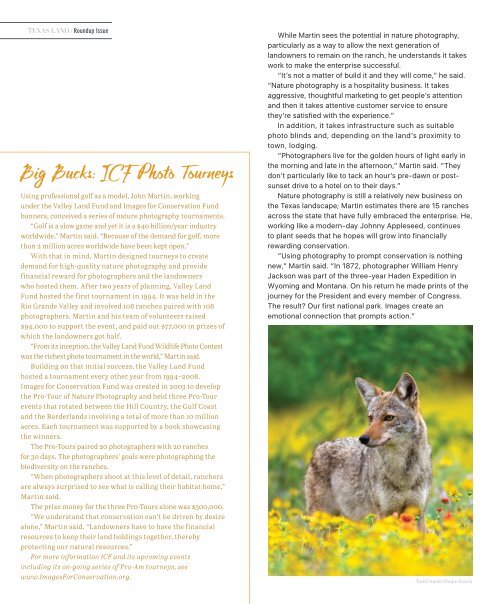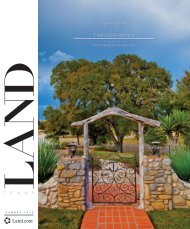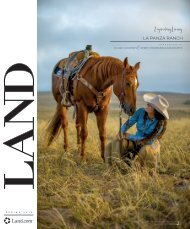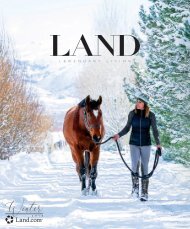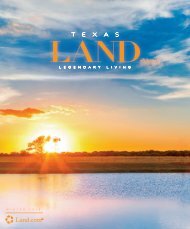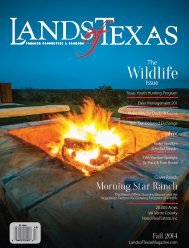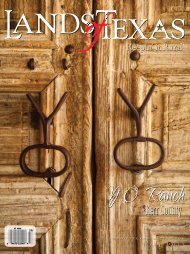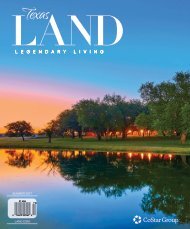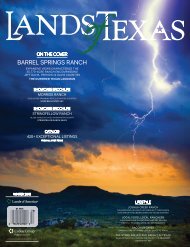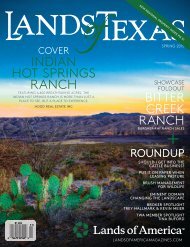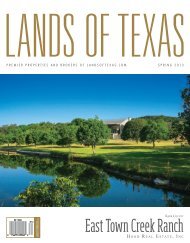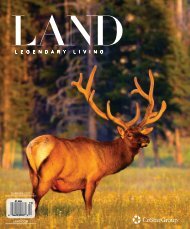Create successful ePaper yourself
Turn your PDF publications into a flip-book with our unique Google optimized e-Paper software.
TEXAS LAND / Roundup Issue<br />
Big Bucks: ICF Photo Tourneys<br />
Using professional golf as a model, John Martin, working<br />
under the Valley Land Fund and Images for Conservation Fund<br />
banners, conceived a series of nature photography tournaments.<br />
“Golf is a slow game and yet it is a $40 billion/year industry<br />
worldwide,” Martin said. “Because of the demand for golf, more<br />
than 2 million acres worldwide have been kept open.”<br />
With that in mind, Martin designed tourneys to create<br />
demand for high-quality nature photography and provide<br />
financial reward for photographers and the landowners<br />
who hosted them. After two years of planning, Valley Land<br />
Fund hosted the first tournament in 1994. It was held in the<br />
Rio Grande Valley and involved 108 ranches paired with 108<br />
photographers. Martin and his team of volunteers raised<br />
$94,000 to support the event, and paid out $77,000 in prizes of<br />
which the landowners got half.<br />
“From its inception, the Valley Land Fund Wildlife Photo Contest<br />
was the richest photo tournament in the world,” Martin said.<br />
Building on that initial success, the Valley Land Fund<br />
hosted a tournament every other year from 1994–2008.<br />
Images for Conservation Fund was created in 2003 to develop<br />
the Pro-Tour of Nature Photography and held three Pro-Tour<br />
events that rotated between the Hill Country, the Gulf Coast<br />
and the Borderlands involving a total of more than 10 million<br />
acres. Each tournament was supported by a book showcasing<br />
the winners.<br />
The Pro-Tours paired 20 photographers with 20 ranches<br />
for 30 days. The photographers’ goals were photographing the<br />
biodiversity on the ranches.<br />
“When photographers shoot at this level of detail, ranchers<br />
are always surprised to see what is calling their habitat home,”<br />
Martin said.<br />
The prize money for the three Pro-Tours alone was $500,000.<br />
“We understand that conservation can’t be driven by desire<br />
alone,” Martin said. “Landowners have to have the financial<br />
resources to keep their land holdings together, thereby<br />
protecting our natural resources.”<br />
For more information ICF and its upcoming events<br />
including its on-going series of Pro-Am tourneys, see<br />
www.ImagesForConservation.org.<br />
While Martin sees the potential in nature photography,<br />
particularly as a way to allow the next generation of<br />
landowners to remain on the ranch, he understands it takes<br />
work to make the enterprise successful.<br />
“It’s not a matter of build it and they will come,” he said.<br />
“Nature photography is a hospitality business. It takes<br />
aggressive, thoughtful marketing to get people’s attention<br />
and then it takes attentive customer service to ensure<br />
they’re satisfied with the experience.”<br />
In addition, it takes infrastructure such as suitable<br />
photo blinds and, depending on the land’s proximity to<br />
town, lodging.<br />
“Photographers live for the golden hours of light early in<br />
the morning and late in the afternoon,” Martin said. “They<br />
don’t particularly like to tack an hour’s pre-dawn or postsunset<br />
drive to a hotel on to their days.”<br />
Nature photography is still a relatively new business on<br />
the <strong>Texas</strong> landscape; Martin estimates there are 15 ranches<br />
across the state that have fully embraced the enterprise. He,<br />
working like a modern-day Johnny Appleseed, continues<br />
to plant seeds that he hopes will grow into financially<br />
rewarding conservation.<br />
“Using photography to prompt conservation is nothing<br />
new,” Martin said. “In 1872, photographer William Henry<br />
Jackson was part of the three-year Haden Expedition in<br />
Wyoming and Montana. On his return he made prints of the<br />
journey for the President and every member of Congress.<br />
The result? Our first national park. Images create an<br />
emotional connection that prompts action.”<br />
Todd Steele/Shape Ranch


